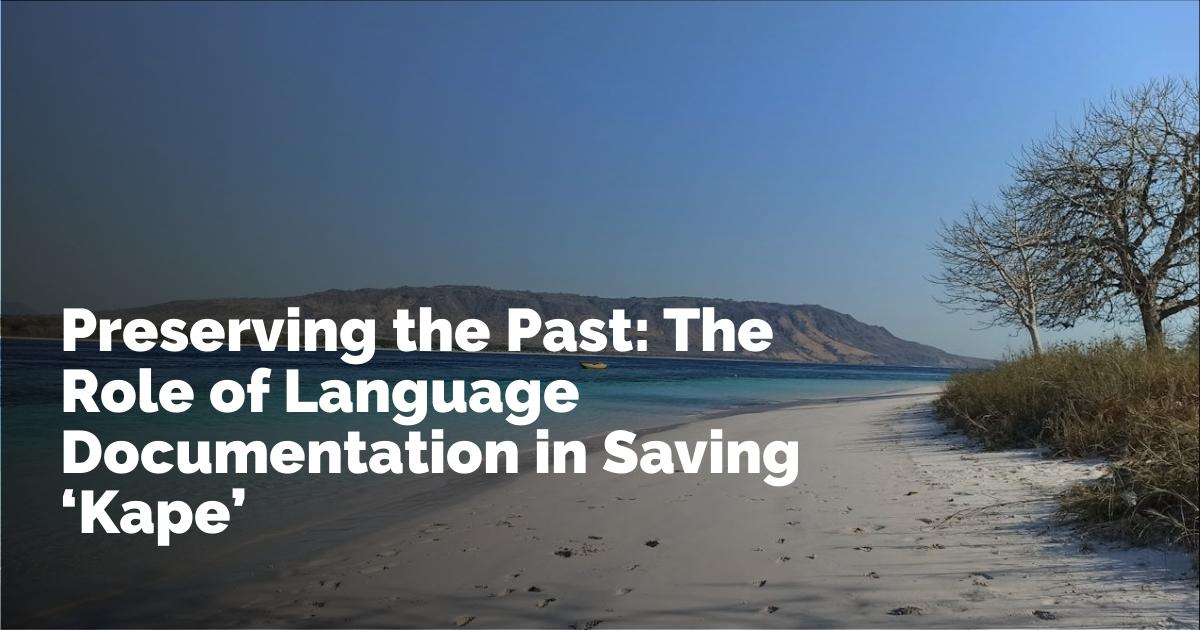Finding 'Kape': The Quest to Preserve an Endangered Language
In the contemporary world, language acts as a crucial element of cultural identity and heritage. However, in an era dominated by globalization, smaller, indigenous languages face the real threat of extinction. Among these endangered languages is Kape, a Papuan language discovered on Alor Island by a dedicated team of linguistic researchers, including Shiyue Wu from Xi'an Jiaotong-Liverpool University. This blog delves into the fascinating process of discovering and documenting the Kape language, highlighting the importance and challenges of this linguistic endeavor.
The Importance of Language Documentation
The world is home to over 7,000 languages, yet only half are properly documented, putting many at risk of vanishing without a trace. The spread of dominant languages like English and Chinese has overshadowed less widely spoken languages, often encouraging parents to prioritize teaching their children these global tongues. As a result, indigenous languages like Copainalá Zoque in Mexico and Northern Ndebele in Zimbabwe face a lack of consistent teaching and transmission to younger generations.
Historically, many indigenous languages remained unwritten, leaving no tangible records for preservation. The absence of written documentation has contributed to the gradual disappearance of these languages as older generations pass away without transferring their linguistic heritage. Language documentarists step in to bridge this gap, aiding in safeguarding these cultural treasures for future generations. By preserving vocabularies, grammatical structures, and cultural narratives, they ensure that linguistic diversity remains an integral part of human heritage.
The Discovery of Kape
In the summer of 2024, during an exhaustive language documentation fieldwork in Alor Island, Shiyue Wu unearthed a linguistic gem: the Kape language. Wu, alongside Abui consultants and native speakers, was initially researching the ritual altars known as 'maasang.' While discussing linguistic variants of altar names, she stumbled upon the term 'mata' used in Kape, a language previously overlooked in linguistic archives.
The word 'Kape,' meaning 'rope,' is apt, symbolizing a connection among its speakers scattered from the mountains to the sea of Alor Island. Geographically and linguistically, Kape finds itself intertwined with languages like Kabola, Kamang, and Abui in the region. Despite sharing mutual intelligibility with Kamang and some lexical similarities with several local languages, Kape's speakers regard themselves as a distinct linguistic and ethnic community, an identity that validates Kape as a language in its own right.
Kape's Linguistic Context and Connections
A fascinating aspect of Kape is its relationship with other Papuan languages on Alor Island, including Suboo, Tiyei, and Adang. The speakers, referred to as 'Kafel' by the Abui people, are generally multilingual. Many of them are fluent in Kape, alongside Kamang, Bahasa Indonesia, Alor Malay, and occasionally Abui.
Despite the absence of historical records for Kape, its linguistic characteristics suggest its antiquity, aligning it with the other indigenous languages of Alor. The critically endangered status of Kape necessitates immediate documentation to ensure its legacy endures amidst the encroachment of more dominant languages.
Challenges in Documenting Endangered Languages
Language Documentation is an ongoing struggle faced with numerous challenges. The primary goal is to reconstruct the unwritten histories of indigenous peoples, securing the future of their cultures and languages. Although external sources like missionary diaries and colonial documents can offer glimpses into the past, they often lack the nuance and expertise needed to capture linguistic intricacies accurately.
The research team at Xi'an Jiaotong-Liverpool University, under the leadership of Francesco Perono Cacciafoco, has devoted more than a decade to documenting the endangered languages of Alor Island. They start from fundamental linguistic elements—lexicons and grammar—extending their explorations into the rich traditions and ancestral wisdom of the native speakers.
Efforts have been made to document Papuan languages such as Abui, Kula, and Sawila, alongside Kape. The small, often scattered communities of speakers closer communicate via languages like Bahasa Indonesia and Alor Malay, partially due to their native languages' neglect in formal education and the broader societal use.
Preserving Kape: A Cultural Imperative
Beyond linguistic significance, safeguarding Kape is a cultural imperative. Documenting and revitalizing Kape entails more than acknowledging its existence; it involves fostering a renewed sense of identity for its community. This process allows speakers to rediscover their history, knowledge, and ancestral traditions that would otherwise be forgotten.
The endeavor to preserve Kape faces a long and challenging road, but with collaboration from local consultants and native speakers, there lies optimism. The journey to document Kape is not just a scientific project; it is a commitment to cultural preservation and an act of solidarity with those striving to keep their linguistic heritage alive for generations to come.
출처 : Original Source

